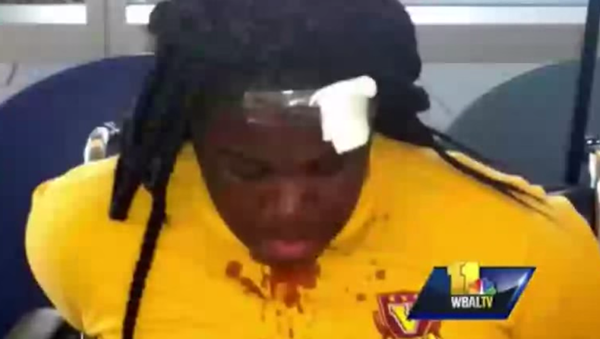One of the girls, identified as Starr, can be seen on the video passing a school police officer during a passing period.
“The officer was hollering at her and said, ‘Little girl, get down here, and so Starr said, ‘My name is not little girl, it’s Starr.’ Starr came on down the steps, and Starr said that’s when the officer grabbed her,” Vanessa Ward, the girl’s grandmother, told WBAL.
The officer can then be seen grabbing the girl and shoving her against a wall. Two other girls, including Starr’s cousin Diamond, get involved and try to pull the officer away. The officer chases them and then pulls out a baton and hits Diamond at least twice, once on the head.
The parents were only notified of the incident when they received calls from paramedics, not from school officials.
“The officer kind of comes from behind and reaches around and sprays them multiple times in the face with pepper spray. It’s disgusting,” said Jared Jaskot, the family’s attorney.
The girls were initially charged with assault and school officials had claimed, along with the officer, that the girls had attacked the officer, punching and kicking. The charges were dropped after the video of the incident revealed that story to be false.
After the family filed a complaint, the officer was placed on administrative leave while an investigation is conducted. Her name was not released.

School Police — Protection or Prison Pipeline?
Despite the emergence of the video the girls were transferred to an alternative school for troubled kids, a decision that the girls’ parents have hired an attorney to fight.
The altercation raises questions about the effect of police officers inside schools. Both the 1999 school shooting in Columbine, Co. and the 2012 shooting in Newtown, Conn. inspired public calls for more police in schools. “The only thing that stops a bad guy with a gun is a good guy with a gun,” the National Rifle Association’s vice president, Wayne LaPierre famously declared a week after the Newtown shootings.
But civil rights advocates worry that more police in schools just means more kids being arrested and brought into the justice system as minor disciplinary infractions become criminalized.
The ACLU of New York, for instance, is currently bringing a civil rights suit against the NYPD whose presence in schools has increased by 73% since 1998 even though school crime was on the decline. The suit alleges the use of excessive force, handcuffing of students and “humiliation and degradation” resulting from police actions that “frequently fail to account for the ways in which policing students in public schools differs from policing adults on the street.”
— ACLU Nation'sCapital (@ACLU_NCA) February 3, 2015
In a December 2012 Senate Subcommittee hearing on the “school to prison pipeline,” and its effect on civil rights, Judith A. Browne Dianis, co-director of the Advancement project, testified that “pushing and shoving in the schoolyard is now a battery, and talking back is now disorderly conduct.”
The use of in-school officers, often called School Resource Officers,has risen steeply in recent years. According to the Department of Justice, the number of full-time officers in city schools increased by around 40% between 1997 and 2007. 23,000 schools in the US, about a third of the total, have armed guards on their premises.


